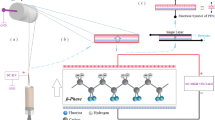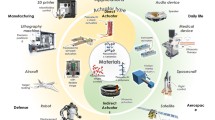Abstract
This paper presents a numerical study on the performance of a PZT (lead zirconate titanate)-bonded aluminium cantilever beam for both sensor and actuator configurations. The effect of varying the dimensions of PZT for two different cases of polarization direction is considered in the study. In case-1, polarization is along the length of PZT, and in case-2, polarization is across the thickness of PZT. The study is also extended for different configurations, types and locations of PZT. The results show that for case-1, the transverse displacement of the aluminium beam increases as the length of PZT decreases. No significant variation in displacement is noted by varying the width of PZT. Under different piezoelectric materials considered, PZT-5H showed maximum displacement. PZT, when located close to the support, showed maximum displacement and voltage response. The numerical results are also compared with one-dimensional analytical solutions and are found to be in good agreement.




























Similar content being viewed by others
References
I. Chopra, Review of state of art of smart structures and integrated systems. AIAA J. 40(11), 2145–2187 (2002)
G. Geymonat, C. Licht, T. Weller, Plates made of piezoelectric materials: When are they really piezoelectric? Appl. Math. Model. 35(1), 165–173 (2011)
T. Bailey, J.E. Ubbard, Distributed piezoelectric-polymer active vibration control of a cantilever beam. J. Guid. Control Dyn. 8(5), 605–611 (1985)
E.F. Crawley, J.D. Luis, Use of piezoelectric actuators as elements of intelligent structures. AIAA J. 25(10), 1373–1385 (1987)
Z. Chaudhry, C.A. Rogers, The pin-force model revisited. J. Intell. Mater. Syst. Struct. 5(3), 347–354 (1994)
L. Li, Z. Xue, C. Li, A modified pin force model for beams with active material bonded. Mater. Des. 97, 249–256 (2016)
E.F. Crawley, E.H. Anderson, Detailed models of piezoceramic actuation of beams. J. Intell. Mater. Syst. Struct. 1(1), 4–25 (1990)
M. Bendary, M. Adnan Elshafei, A.M. Riad, Finite element model of smart beams with distributed piezoelectric actuators. J. Intell. Mater. Syst. Struct. 21(7), 747–758 (2010)
A. Nechibvute, A.R. Akande, P.V.C. Luhanga, Pertan. J. Sci. Technol. 19(2), 259–271 (2011)
A.R. Biswala, T. Roya, R.K. Beheraa, P.K. Paridab, S.K. Pradhanb, Finite element based modeling of a piezolaminated tapered beam for voltage generation. Proc. Eng. 144, 613–620 (2016)
M. Zheng, M. Gudarzi, Q.-M. Wang, Modeling, fabrication and analysis of a flexible PZT-polymer laminated composite cantilever beam in sensing and actuation modes, in IEEE International Ultrasonics Symposium (IEEE, 2017)
M.H. Shen, A new modeling technique for piezoelectrically actuated beams. Comput. Struct. 57(3), 361–366 (1995)
S. Narayanan, V. Balamurugan, Finite element modelling of piezolaminated smart structures for active vibration control with distributed sensors and actuators. J. Sound Vib. 262(3), 529–562 (2003)
N. Fallah, M. Ebrahimnejad, Finite volume analysis of adaptive beams with piezoelectric sensors and actuators. Appl. Math. Model. 38(2), 722–737 (2014)
L.N. Sulbhewar, P. Raveendranath, A Timoshenko piezoelectric beam finite element with consistent performance irrespective of geometric and material configurations. Latin Am. J. Solids Struct. 13(5), 992–1015 (2016)
R.L. Wankhade, K.M. Bajoria, Numerical optimization of piezolaminated beams under static and dynamic excitations. J. Sci. Adv. Mater. Dev. 2(2), 255–262 (2017)
E.F. Crawley, K.B. Lazarus, Induced strain actuation of isotropic and anisotropic plates. AIAA J. 29(6), 944–951 (1991)
C.H. Hong, I. Chopra, Modeling and validation of induced strain actuation of composite coupled plates. AIAA J. 37(3), 372–377 (1999)
A. Suleman, V.B. Venkayya, A simple finite element formulation for a laminated composite plate with piezoelectric layers. J. Intell. Mater. Syst. Struct. 6(6), 776–782 (1995)
H.S. Tzou, R. Ye, Analysis of piezoelastic structures with laminated piezoelectric triangle shell elements. AIAA J. 34(1), 110–115 (1996)
Z. Robert, R. Raimund, R. Michael, T. Jan, High-performance four-node shell element with piezoelectric coupling for the analysis of smart laminated structures. Int. J. Numer. Method Eng. 70(8), 934–961 (2007)
N. Tamara, M. Dragan, S. Somu, T. Miroslav, User defined finite element for modeling and analysis of active piezoelectric shell structures. Meccanica 49(8), 1763–1774 (2014)
D.J. Leo, Engineering Analysis of Smart Material Systems (Wiley, New Jersy, 2007)
J. Gawryluk, A. Mitura, A. Teter, Experimental and numerical studies on the static deflection of the composite beam with the MFC element. Mech. Mech. Eng. 20(2), 97–108 (2016)
A. Nechibvute, C. Albert, L. Pearson, Finite element modeling of a piezoelectric composite beam and comparative performance study of piezoelectric materials for voltage generation. ISRN Mater. Sci. 2012, 11 (2012)
M. Aslam, P. Nagarajan, M. Remanan, Analysis of piezoelectric solids using finite element method, in IOP Conference Series: Materials Science and Engineering, vol 330. (IOP Publishing, 2018)
S. Timoshenko, G.H. MacCullough, Elements of Strength of Materials (Van Nostrand Reinhold Company, New York, 1935)
Q. Wang, W. Yu, Asymptotic multiphysics modeling of composite slender structures. Smart Mater. Struct. 21(3), 1–11 (2012)
eFunda: Piezo Material Data. http://www.efunda.com/materials/piezo/material_data/matdata_index.cfm. Accessed 01 Dec 2017
Author information
Authors and Affiliations
Corresponding author
Rights and permissions
About this article
Cite this article
Aslam, M., Nagarajan, P. & Remanan, M. Numerical Studies on PZT-Bonded Aluminium Beam. J. Inst. Eng. India Ser. A 100, 117–130 (2019). https://doi.org/10.1007/s40030-018-0340-5
Received:
Accepted:
Published:
Issue Date:
DOI: https://doi.org/10.1007/s40030-018-0340-5




